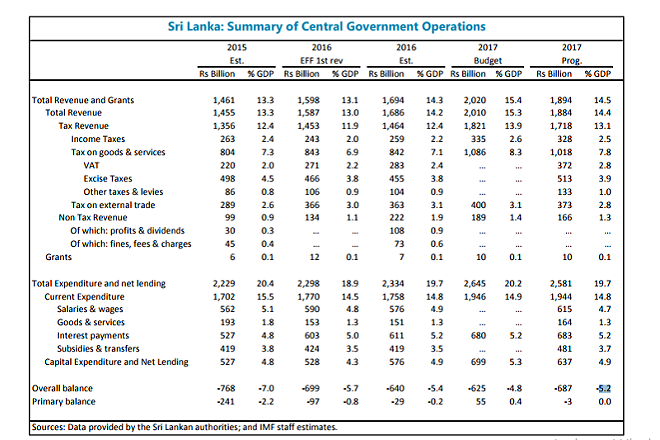Aug 11, 2017 (LBO) - Sri Lanka's overall fiscal deficit decreased from 7 percent to 5.4 percent of GDP between 2015 and 2016, with public finances strengthening under an IMF supported program, the fund said releasing its country report.
The budget deficit is projected to fall to 5.2 percent of GDP in 2017, although the figure is up from a previously budgeted 4.8 percent.
Sri Lanka's fiscal consolidation, considered key to improving macroeconomic fundamentals, now hinges on the new Inland Revenue Act which is expected to "make the tax system more efficient and equitable, and generate resources for social and development programs."
"The Inland Revenue Department has started preparing for its implementation, including by establishing a steering committee and project teams, drafting detailed tax manuals, and initiating communication with stakeholders," the IMF said.
One key figure, Sri Lanka's tax-to-GDP ratio, remained unchanged at 12.4 percent in 2016.
The new target for 2017 is 13.1 percent of GDP, although this is a downward revision from the 13.9 percent projected in the budget.
Sri Lanka included automatic fuel and electricity pricing mechanisms in its benchmarks under the 1.5 billion dollar Extended Fund Facility, but the government has held back on this, given its political sensitivity.
"The target date has been reset to allow time for public consultation and education, followed by a sequence of reforms to put the reform process back on track."
The 36-month IMF facility for roughly 1.5 billion dollars was approved in June 2016, and the second review was completed in July this year bringing total disbursements to around 501 million dollars.
The IMF noted that public debt rose from 82 to 84 percent of GDP between 2015 and 2016 largely due to exchange rate depreciation and an increase in guaranteed debt.
"Public debt is expected to rise slightly to 85 percent of GDP in 2017 due to still large fiscal deficit and exchange rate depreciation.
buy clomiphene online
buy clomiphene online no prescription
"
"The medium-term overall deficit target of 3.5 percent of GDP remains appropriate for reducing the risk of debt distress, and would lower the public debt to GDP ratio to 76 percent of GDP by 2020 under the programmed fiscal consolidation."
If contingent state-owned enterprise debt is included, total public debt would rise to 94 percent of GDP.
"External debt remains sustainable but is high at 57 percent of GDP and vulnerable to currency risks. And rollover need will increase as external sovereign debt begins to mature in 2019, calling for advance planning and medium-term debt management," the IMF said.



